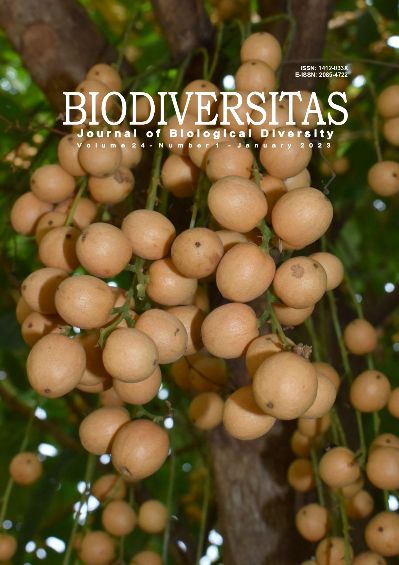Limnonectes from Enggano Island (Indonesia) with comments on its taxonomic status
##plugins.themes.bootstrap3.article.main##
Abstract
Abstract. Gonggoli AD, Atmajaya VY, Kadafi AM, Arida EA, Hamidy A. 2023. Limnonectes from Enggano Island (Indonesia) with comments on its taxonomic status. Biodiversitas 24: 473-480. Limnonectes shompenorum is a fanged frog known to be distributed in the satellite islands of the western coast of Sumatra and some parts of mainland Sumatra. This frog was also recorded in Enggano Island, but the taxonomic status and morphological data information still need to be studied. Herein, we examined L. shompenorum from Enggano Island based on molecular methods using the 16S rRNA gene and redescribed its morphological characters. The phylogenetic trees were constructed using Neighbor-Joining (NJ), Maximum Likelihood (ML), and Bayesian Inference (BI) analysis, and morphological measurements were taken using 23 characters. The results demonstrate that L. shompenorum is a monophyletic group and a sister taxon of L. macrodon. The monophyletic group of L. shompenorum consists of two clades (A and B) with relatively large genetic distances within the population (0.00-5.10%), representing distinct interspecific lineages. Clade A consists of the Enggano population with a genetic distance within the population of 0.00-0.48%, and clade B consists of the Mentawai Islands and Mainland Sumatra with a genetic distance within the population of 1.48-2.74%. The Enggano population is closer to the Mentawai population (2.47-2.74%) than the Sumatra population (3.52-5.10%). Our genetic data aligns with previous studies that indicate the Enggano population possibly comes from the Mentawai population. Morphologically, L. shompenorum from Enggano Island is similar to the original description, however it has consistent, distinctive characteristics by having the fourth finger longer than the second finger in females. Further research using broader molecular data, including the holotype population, is needed to confirm the taxonomic status of L. shompenorum.
##plugins.themes.bootstrap3.article.details##
Most read articles by the same author(s)
- MUHAMMAD ALIF FAUZI, AMIR HAMIDY, NIA KURNIAWAN, Harvesting trends of Amboina box turtles (Cuora amboinensis) seventeen years after listing in Appendix II CITES , Biodiversitas Journal of Biological Diversity: Vol. 21 No. 3 (2020)
- TAUFAN NURZAMAN SULAEMAN, AMIR HAMIDY, ACHMAD FARAJALLAH, ANTOINE FOUQUET, AWAL RIYANTO, EVY ARIDA, MULYADI, WAHYU TRILAKSONO, MISBAHUL MUNIR, Mitochondrial DNA suggests the existence of two distinct species in Moluccas and New Guinea within Nyctimystes infrafrenatus (Günther, 1867) , Biodiversitas Journal of Biological Diversity: Vol. 22 No. 8 (2021)
- RURY EPRILURAHMAN, VESTIDHIA YUNISYA ATMAJA, MISBAHUL MUNIR, ROSICHON UBAIDILLAH, TUTY ARISURYANTI, ERIC NELSON SMITH, AMIR HAMIDY, Phylogeny and taxonomic status evaluation of Dark-sided Narrow-mouthed Frog, Microhyla heymonsi, (Anura: Microhylidae) from Sumatra, Indonesia , Biodiversitas Journal of Biological Diversity: Vol. 24 No. 2 (2023)


 https://orcid.org/0000-0003-2748-3017
https://orcid.org/0000-0003-2748-3017